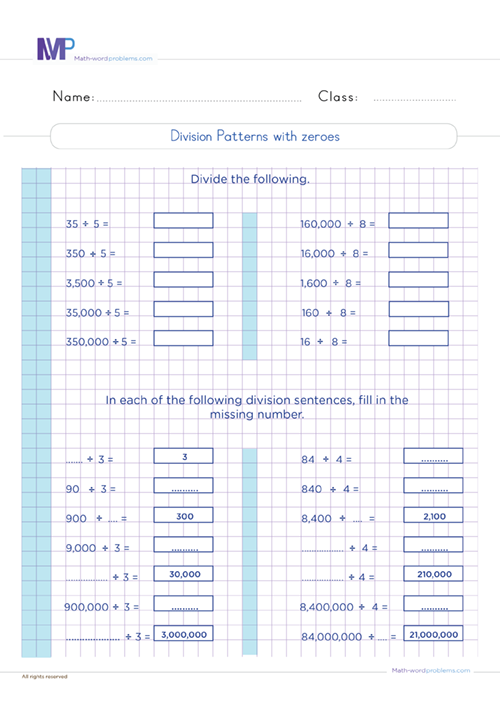 How to divide decimals by whole numbers word problems
How to divide decimals by whole numbers word problems
The best way for 6th graders to know how to divide decimals by whole numbers word problems is by engaging in this fantastic resource. They will discover the best structure and solid routine way of dividing decimals by whole numbers word problems. This systematic way of solving word problems will help support, develop and broaden kids’ minds when they engage themselves in tackling complex problems.
An interesting thing about this resource is that young learners will have fun tackling word problems rather than having a biased mind about word problems.
Steps to solve division of decimals by whole numbers word problems
Below are simple steps to solve division of decimals by whole numbers word problems with no stress. These steps have remarkable strategies, especially for efficiently handling complex division of decimals by whole numbers word problems.
Also, these steps have stressed the importance of reading comprehension skills, which are effective for appropriately dividing decimals by whole numbers word problems. Hence, a successful word problem solver must love reading and possess excellent reading comprehension skills.
In this light, we have designed stimulating real-life examples so that kids can see the connection between math in the classroom and the real world.
Step 1: IDENTIFY:
This is a very important step when it comes to word problems because this is where the reading comprehension skills are manifested. Read the whole problem carefully and identify important numbers and keywords in the word problem.
For instance, if you come across one of the following keywords in a word problem: - divide, half, evenly, every, per, parts, out of, quotient of, ratio of, how many in each, equal parts, cut up, average, as much, etc., then it implies that you have to perform a Division Operation.
- ***One key Element for learners to understand is that they should not always rely on keywords alone. That is to say; the same keyword can have different meanings in different word problems.
- For this reason, we reiterate on the importance of reading the question very carefully to understand the situation that the word problem is describing, then figure out exactly which operation to use***
Step 2: STRATEGIZE:
Think on how you will solve or go about to solve the word problem.
- First, from the keyword(s) in the word problem, you will know if you are going to perform but a Division Operation or Not.
- What is more is that, you must not count only on keywords. Furthermore try to understand the situation that the problem is describing.
- Then, after knowing which operation you are going to perform, create short expressions/sentences to represent the given word problem.
Step 3: SET UP:
Now, write down a numerical expression that represents the information given in the word problem.
Step 4: PROVIDE A SOLUTION:
From step 3 above, divide the values by using the long division method. Furthermore, Pad with zeros if necessary in the long division. Also, recall the unit of measurement if any.
Step 5: CHECK YOUR WORK:
Finally, ask yourself this question. Does my answer make sense? If “YES”, you are done. If “NO”, go back to step 1 and start all over again.
Example on how to perform division of decimals by whole numbers word problems
Step 1: First, look out for the important numbers while reading the word problem. You see that, these numbers are 1,484.99 kilograms and 15. The keyword found in the word problem is “each”.
Step 2: Next, how will you solve the problem? You see that, the situation the problem is describing and the keyword(s) found in the word problem calls for you to perform a division operation.
Then, as you read further, you’ll get to realise that you have been asked to present your final answer in grams instead of the initial unit which is kilograms. So, this calls for you to visit your metric unit of measurement conversion table on weight.
In addition, after knowing which operation you are going to perform, Construct short expressions/sentences to represent the given word problem.
- Total weight of the bags of cement = 1,484.99kg.
- Number of bags of cement = 15.
- Therefore, weight of each bag of cement = Total weight of the bags of cement ÷ Number of bags of cement.
Step 3:Now, write down a numerical expression to represent the bolded sentence in step 2 above:
1,484.99kg ÷ 15 = ?
Step 4: after that, from step 3 above, set up a long division sign, arrange the numbers on it and then solve using the long division steps. Furthermore, pad with zeros if necessary. Always recall the unit of measurement if any.
If 1 kg = 1000 g,
Then 98.99 kg = (1000 × 98.99) g
= 98,990 g
So, the weight of each bag was 98,990 grams.
Step 5: Finally, check out your work i.e. if the answer makes sense by estimating the numbers and doing mental calculation. If the answer is so close to the one you have, then your answer is correct but if the answer is not close to your answer, then go back to step 1.




